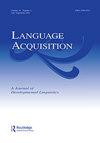Structural intervention effects in the acquisition of sluicing
IF 1.3
3区 文学
0 LANGUAGE & LINGUISTICS
引用次数: 3
Abstract
ABSTRACT Experimental studies show that children have greater difficulty with wh-extraction from object position than subject position, arguably an intervention effect (e.g., Relativized Minimality). In this study we provide additional evidence of a S/O asymmetry in A’-dependencies from a novel source—sluicing. The results of our first comprehension study show that English-speaking 3–6-year-olds obey the “identity condition” on sluicing—that is, they disallow interpretations in which the elided verb or arguments are distinct from their antecedent. Importantly, our results also show a subject > object asymmetry and thereby support syntactic theories of sluicing that posit a fully articulated (but unpronounced) TP at the ellipsis site from which the wh-phrase has been extracted, e.g., Someone wrote this paper, but I don’t know who <_ wrote this paper>, as opposed to certain semantic/pragmatic theories that posit no such structure. Our second comprehension study investigates the role of animacy. We find that children’s comprehension of object sluices, but not subject sluices, improves significantly when there is a mismatch in animacy features. Our results are incompatible with models that are solely frequency based but rather provide evidence for structure-based intervention effects. We conclude that subject > object asymmetries can be found even in instances in which the intervener is not overt, such as sluicing, and that [animacy] may be a feature involved in the computation of intervention.水闸获取中的结构干预效应
摘要实验研究表明,儿童从物体位置提取wh比从主体位置提取困难,这可以说是一种干预效应(例如,相对最小性)。在这项研究中,我们从一个新的来源——冲洗——提供了a’依赖性S/O不对称的额外证据。我们的第一项理解研究结果表明,说英语的3-6岁儿童在出句时遵守“同一性条件”,也就是说,他们不允许省略的动词或论据与其先行词不同的解释。重要的是,我们的研究结果还显示了主语>宾语的不对称性,从而支持了在提取wh短语的省略位置放置完全表达(但未发音)的TP的句法理论,例如,Someone写了这篇论文,但我不知道是谁写的,而不是某些没有放置这种结构的语义/语用理论。我们的第二个理解研究调查了动物的作用。我们发现,当动物特征不匹配时,儿童对客体的理解能力会显著提高,而对主体的理解能力则不会提高。我们的结果与仅基于频率的模型不兼容,而是为基于结构的干预效果提供了证据。我们得出的结论是,即使在干预者不公开的情况下,也可以发现主体>客体的不对称性,例如冲洗,并且[动物性]可能是干预计算中涉及的一个特征。
本文章由计算机程序翻译,如有差异,请以英文原文为准。
求助全文
约1分钟内获得全文
求助全文
来源期刊

Language Acquisition
Multiple-
CiteScore
2.30
自引率
8.30%
发文量
20
期刊介绍:
The research published in Language Acquisition: A Journal of Developmental Linguistics makes a clear contribution to linguistic theory by increasing our understanding of how language is acquired. The journal focuses on the acquisition of syntax, semantics, phonology, and morphology, and considers theoretical, experimental, and computational perspectives. Coverage includes solutions to the logical problem of language acquisition, as it arises for particular grammatical proposals; discussion of acquisition data relevant to current linguistic questions; and perspectives derived from theory-driven studies of second language acquisition, language-impaired speakers, and other domains of cognition.
 求助内容:
求助内容: 应助结果提醒方式:
应助结果提醒方式:


